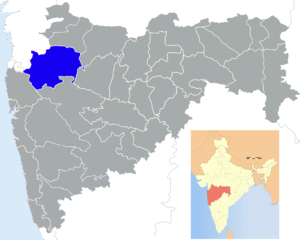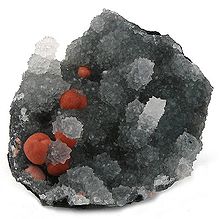- Nashik district
-
Nashik district
नाशिक जिल्हा
Location of Nashik district in MaharashtraState Maharashtra,  India
IndiaAdministrative division Nashik Division Headquarters Nashik Area 15,530 km2 (6,000 sq mi) Population 49,93,796 (2001) Population density 321.56 /km2 (832.8 /sq mi) Tehsils 1. Nashik, 2. Sinnar, 3. Igatpuri, 4. Trimbak, 5. Niphad, 6. Yeola, 7. Peth, 8. Dindori, 9. Chandwad, 10. Nandgaon, 11. Surgana, 12. Kalwan, 13. Deola, 14. Baglan, 15. Malegaon[1] Lok Sabha Constituencies 1. Nashik, 2. Dindori (ST), 3. Dhule (shared with Dhule district) Based on (Election Commission website) Major highways NH-3, NH-50 Official website Nashik district, also known as Nasik district, is a district in Maharashtra, India. The city of Nashik is the administrative headquarters of the district.
Contents
Geography
Nashik district has an area of 15,530 square kilometres. It is bounded by Dhule district to the north, Jalgaon district to the east, Aurangabad district to the southeast, Ahmadnagar district to the south, Thane district to the southwest, Valsad and Navsari districts of Gujarat to the west, and The Dangs district to the northwest.
The Western Ghats or Sahyadri range stretches from north to south across the western portion of the district. With the exception of the westernmost few villages, the western portion is hilly, and intersected by ravines, and only the simplest kind of cultivation is possible. The western slope of the Ghats is drained by several rivers, including the Daman Ganga River, which drains westwards to the Arabian Sea.
The larger eastern portion of the district, which lies on the Deccan Plateau, is open, fertile, and well cultivated. The Chander Range, which runs east and west, forms the chief divide of the plateau region. The Godavari River originates in the district and drains east towards the Bay of Bengal, and all the streams to the south of the Chander Range, including the Kadwa and Darna, are tributaries of the Godavari. To the north of the Chander Range, the Girna River and its tributary, the Mosam, flow westward through fertile valleys into the Tapti River.
Climate
Extremes: max 42.4 °C (108.3 °F) on May 12, 1960, at Nasik. The lowest, also at Nasik, was 0.6 °C (33.1 °F) on January 7, 1945.[2]
Climate data for Nashik Month Jan Feb Mar Apr May Jun Jul Aug Sep Oct Nov Dec Year Average high °C (°F) 29
(84)31
(88)35
(95)37
(99)37
(99)32
(90)28
(82)27
(81)29
(84)32
(90)31
(88)29
(84)31.4
(88.6)Average low °C (°F) 10
(50)12
(54)16
(61)20
(68)22
(72)23
(73)22
(72)21
(70)21
(70)18
(64)14
(57)12
(54)18
(63.6)Precipitation mm (inches) 1.1
(0.043)0.4
(0.016)3.4
(0.134)6.7
(0.264)16.2
(0.638)98.1
(3.862)206.4
(8.126)134.6
(5.299)146.1
(5.752)49.0
(1.929)21.3
(0.839)7.2
(0.283)690.5
(27.185)Source: wunderground.com[3] Demographics
According to the 2011 census Nashik district has a population of 6,109,052,[4] roughly equal to the nation of El Salvador[5] or the US state of Missouri.[6] This gives it a ranking of 11th in India (out of a total of 640).[4] The district has a population density of 393 inhabitants per square kilometre (1,020 /sq mi) .[4] Its population growth rate over the decade 2001-2011 was 22.33 %.[4] Nashik has a sex ratio of 931 females for every 1000 males,[4] and a literacy rate of 80.96 %.[4]
The district is 75.64% urban as of 2007.[7]
Languages
Languages spoken include Ahirani, a Kandeshi tongue with approximately 780 000 speakers, similar to Marathi and Bhili.[8]
Divisions
Administratively, the district is divided into fifteen talukas, which are grouped into four sub-divisions:
- Nashik sub-division: Dindori, Igatpuri, Nashik, Nashik Road, Peth, Trimbakeshwar,
- Malegaon sub-division: Chandwad, Malegaon, Nandgaon
- Niphad sub-division: Niphad, Sinnar, Yeola
- Kalwan sub-division, Deola, Kalwan, Baglan (Satana), Surgana
- The Nashik district is under proposal to be bifurcated and a separate Malegaon district be carved out of existing Nashik district.
History
In the 18th century, the present-day Nashik district was part of the Maratha Confederacy, within the territory controlled directly by the Maratha Peshwa. The district contains several old hill forts, the scenes of many engagements during the Anglo-Maratha Wars. The district became British territory in 1818 on the overthrow of the Peshwa. The present-day district was initially divided between Kandesh and Ahmadnagar districts of Bombay Presidency, a province of British India. Nashik district was created in 1869. The population in 1901 was 816,504, showing a decrease of 3% in the decade 1891-1901. The principal crops were millet, wheat, pulse, oil-seeds, cotton and sugar cane. There were also some vineyards, and much garden cultivation. Yeola was an important centre for weaving silk and cotton goods. There were flour-mills at Malegaon, railway workshops at Manmad and Igatpuri, and cantonments at Deolali and Malegaon. At Sharanpur was a Christian village, with an orphanage of the Church Missionary Society, founded in 1854. In 1861 the main northeast line of the Great Indian Peninsula Railway was completed across the district, and in 1878 a chord line was completed between Manmad, on the northeast line in Nashik district, and Daund, on the southeast line in Pune district.
From India's independence to 1960, Nashik district was part of Bombay State, which in 1960 split into the states of Maharashtra and Gujarat.
Places of interest
The Kumbh mela is held after every twelve years at Nashik.
- Trimbakeshwar One of the twelve Jyotirlingas
- Vani or SaptaShrungi
- Muktidham
- Kalaram Temple
- Ozar
- Kalsubai
- Someshwar
- Mangi Tungi
- Devlali
Notes
- ^ Based in part on "Map of talukas", Nashik district
- ^ [1]
- ^ "Historical Weather for Delhi, India". Weather Underground. June 2011. http://www.wunderground.com/NORMS/DisplayIntlNORMS.asp?CityCode=42182&Units=both. Retrieved November 27, 2008.
- ^ a b c d e f "District Census 2011". Census2011.co.in. 2011. http://www.census2011.co.in/district.php. Retrieved 2011-09-30.
- ^ US Directorate of Intelligence. "Country Comparison:Population". https://www.cia.gov/library/publications/the-world-factbook/rankorder/2119rank.html. Retrieved 2011-10-01. "El Salvador 6,071,774 July 2011 est."
- ^ "2010 Resident Population Data". U. S. Census Bureau. http://2010.census.gov/2010census/data/apportionment-pop-text.php. Retrieved 2011-09-30. "Missouri 5,988,927"
- ^ [2]
- ^ M. Paul Lewis, ed (2009). "Ahirani: A language of India". Ethnologue: Languages of the World (16th edition ed.). Dallas, Texas: SIL International. http://www.ethnologue.com/show_language.asp?code=ahr. Retrieved 2011-09-28.
Chandwad
References
- Hunter, William Wilson, Sir, et al. (1908). Imperial Gazetteer of India, Volume 18, pp 398–409. 1908-1931; Clarendon Press, Oxford.
 This article incorporates text from a publication now in the public domain: Chisholm, Hugh, ed (1911). Encyclopædia Britannica (11th ed.). Cambridge University Press.
This article incorporates text from a publication now in the public domain: Chisholm, Hugh, ed (1911). Encyclopædia Britannica (11th ed.). Cambridge University Press.
External links

Navsari district, Gujarat Dang district, Gujarat Dhule district 
Valsad district, Gujarat 
Jalgaon district
Aurangabad district Nashik district
Nashik district 

Thane district Ahmadnagar district  State of Maharashtra
State of MaharashtraCapital : Mumbai Topics Regions Desh · Khandesh · Konkan · Mumbai Metropolitan Region · Marathwada · Vidarbha
Districts Ahmednagar · Akola · Amravati · Aurangabad · Beed · Bhandara · Buldhana · Chandrapur · Dhule · Gadchiroli · Gondia · Hingoli · Jalgaon · Jalna · Kolhapur · Latur · Mumbai (City) · Mumbai (Suburban) · Nagpur · Nanded · Nandurbar · Nashik · Osmanabad · Parbhani · Pune · Raigad · Ratnagiri · Sangli · Satara · Sindhudurg · Solapur · Thane · Wardha · Washim · Yavatmal
Million-plus Cities
in MaharashtraMumbai · Pune · Nagpur · Thane · Pimpri-Chinchwad · Nashik · Kalyan-Dombivali · Navi Mumbai · Aurangabad
Other Cities with
Municipal CorporationsAhmednagar · Akola · Amravati · Bhiwandi · Chandrapur · Dhule · Jalgaon · Kolhapur · Latur · Malegaon · Mira-Bhayandar · Nanded · Parbhani · Solapur · Ulhasnagar · Vasai-Virar ·
Portal : Maharashtra Nashik district topics Rivers and lakes 
Cities and towns Monuments Education Lok Sabha constituencies Vidhan Sabha constituencies Chandwad · Dindori · Kalvan · Malegaon Central · Nandgaon · Nashik Central · Niphad · Sinnar · YewlaMajor Highways
Wikimedia Foundation. 2010.


